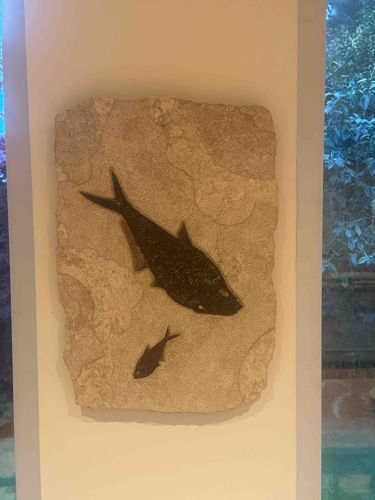
Two Fossil Fish in Matrix
This item is a fossil display featuring two fish embedded in a light-colored, irregularly shaped sedimentary rock matrix. The matrix itself appears to be a natural stone or shale, exhibiting a rough, uneven texture with various shades of light brown, beige, and possibly light gray, suggesting a natural geological formation. The edges of the matrix are uneven and appear to be naturally fractured or minimally shaped to form a displayable plank-like piece. Two distinct fish fossils are prominently displayed on the surface of this matrix. The larger fish, positioned towards the top and center-left, measures approximately 10-12 inches in length. It displays a dark, almost black coloration, contrasting sharply with the lighter matrix. Its form is well-preserved, showing clear outlines of the body, head, fins (dorsal, caudal, pectoral), and tail. The scales are subtly visible under magnification, indicating good preservation. The smaller fish, located below and slightly to the right of the larger specimen, measures roughly 3-4 inches in length and shares a similar dark coloration and level of detail, although details are less discernible due to its size. Both fish are positioned as if swimming, creating a dynamic visual. There are no visible repairs or significant damage to the fossils themselves, though the matrix shows natural inconsistencies inherent to rock. The overall condition appears to be excellent for a fossil of this type, with good preservation of the organisms. There are no apparent maker's marks or signatures. Given the context of 'Yellow River' and '50 million years old', this suggests a likely origin from the Eocene epoch, possibly from a lacustrine (lake) environment known for exceptional fossil preservation, such as the Green River Formation, which is occasionally misidentified or broadly categorized during trade in other regions, or another formation of similar age. This piece demonstrates natural artistry and scientific significance, offering a glimpse into ancient aquatic life. The craftsmanship is primarily natural, highlighting the quality of the fossil preparation to expose the specimens effectively from the surrounding rock.
AI-Generated Appraisal Disclaimer
Estimated Value
$800-1,200
Basic Information
Category
Fossil / Paleontological Specimen
Appraised On
December 1, 2025
Estimated Value
$800-1,200
Additional Details Provided By Owner
User Provided Information
Fossil, yellow river, 50 million years old
Item Description
This item is a fossil display featuring two fish embedded in a light-colored, irregularly shaped sedimentary rock matrix. The matrix itself appears to be a natural stone or shale, exhibiting a rough, uneven texture with various shades of light brown, beige, and possibly light gray, suggesting a natural geological formation. The edges of the matrix are uneven and appear to be naturally fractured or minimally shaped to form a displayable plank-like piece. Two distinct fish fossils are prominently displayed on the surface of this matrix. The larger fish, positioned towards the top and center-left, measures approximately 10-12 inches in length. It displays a dark, almost black coloration, contrasting sharply with the lighter matrix. Its form is well-preserved, showing clear outlines of the body, head, fins (dorsal, caudal, pectoral), and tail. The scales are subtly visible under magnification, indicating good preservation. The smaller fish, located below and slightly to the right of the larger specimen, measures roughly 3-4 inches in length and shares a similar dark coloration and level of detail, although details are less discernible due to its size. Both fish are positioned as if swimming, creating a dynamic visual. There are no visible repairs or significant damage to the fossils themselves, though the matrix shows natural inconsistencies inherent to rock. The overall condition appears to be excellent for a fossil of this type, with good preservation of the organisms. There are no apparent maker's marks or signatures. Given the context of 'Yellow River' and '50 million years old', this suggests a likely origin from the Eocene epoch, possibly from a lacustrine (lake) environment known for exceptional fossil preservation, such as the Green River Formation, which is occasionally misidentified or broadly categorized during trade in other regions, or another formation of similar age. This piece demonstrates natural artistry and scientific significance, offering a glimpse into ancient aquatic life. The craftsmanship is primarily natural, highlighting the quality of the fossil preparation to expose the specimens effectively from the surrounding rock.
Related Tags
Get Your Items Appraised
Instant estimates of your treasures with AI-powered instant appraisals